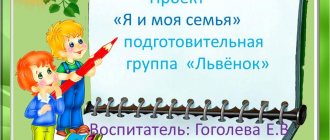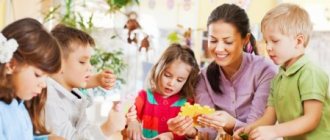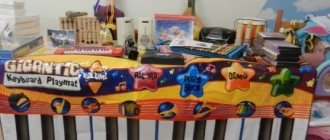Project My Family
Pedagogical project
Second junior group
"DOLPHINS"
“... The family is the primary bosom of human culture... Here the dormant forces of the personal soul awaken and begin to unfold; here the child learns to love (who and how?), believe (in what?) and sacrifice (what and with what?); here the first foundations of his character are formed; here the main sources of his future happiness and unhappiness are revealed in the child’s soul; here the child becomes a little person, from whom a great personality or, perhaps, a low rogue subsequently develops.”
Ivan Alexandrovich Ilyin
Relevance of the project:
When raising children of the first junior group, already at this age we think about how to develop and shape the child’s personality, to raise a real citizen with moral qualities, patriotic feelings and civic position. And our first helpers in this direction, of course, are the family. For a small child, mom and dad are a world in which the foundations of morality are laid, a feeling of love for everything that surrounds the little citizen, and a tolerant attitude towards people.
The family has the main social function - raising children. It was and remains a vital environment for the preservation and transmission of social and cultural values, a determining factor in the formation of a child’s personality. The feeling of love for one’s home, for the Motherland, arises in the family.
Unfortunately, nowadays in our country, for many reasons, family ties are weakening, and traditional family upbringing is becoming a thing of the past. This process can and should be stopped by us preschool teachers - the people who communicate most closely with children and their parents.
At present, when the upbringing and development of a preschool child is greatly negatively influenced by the employment and detachment of parents, access to mass pseudoculture, weakening family ties and connections between generations, the task of moral and civic education in the educational process of a preschool educational institution has become more urgent. .
The formation of new approaches to the development of a parenting culture is based on increasing the status of the family in the eyes of parents, in the eyes of their children and teachers. In addition, teachers convey the idea that the culture of parenthood is laid down in childhood, and throughout life, before entering marriageable age, children develop a certain stereotype of family relationships, which, when grown up, children will begin to implement in their family life.
Target:
form children’s primary ideas about family, family
traditions, responsibilities; instill in children love and respect for
all family members; develop sociability and communication skills.
Tasks:
- Teach children to understand the roles of adults and children in the family, to give an idea of the moral behavior between them.
- Strengthen the ability to name family members, instill in the child joy and pride in having a family, and a feeling of gratitude for caring.
- To promote the active involvement of parents in joint activities with the child in family and kindergarten settings.
- Establishing partnerships with the family of each child.
- Summarize child-parent relationships through the experience of joint creative activity.
Estimated results of the project implementation:
- Revival of family education traditions;
- Application by parents of pedagogical knowledge about raising children in the family;
- Development of partnerships in the family.
Project type:
informational - educational, creative
Project duration:
long-term (from September 2016 - May 2022)
Project participants:
Children of the group "DOLPHINS", parents and teachers
Educational areas:
“Physical development”, “Social and communicative development”, “Cognitive development”, “Artistic and aesthetic development”, “Speech development”
Expected result:
Children
- An idea of the family, knowledge of all families has been formed.
- Positive relationships have been formed between children and parents.
Parents
- Partnership relationships have been established with the group’s teachers.
- Developed creative potential through joint creative activities.
- Parents have shown interest in holding joint
creative activities with children and group teachers.
- Parents’ pedagogical competence and confidence in
own pedagogical capabilities.
Teachers
- All conditions have been created for cooperation between teachers and parents and children,
visual and informational material has been selected, awareness in
various issues of raising children.
- The optimal ways of interaction in educational influence have been determined
per child.
Project implementation stages
First stage : Preparatory (preliminary work)
Reading the story by D. Grabe “Mom” Conversation based on what was read.
- Tell me, who in the family takes care of the children the most?
- What mom? Why do we live with our family?
- Why are there both mom and dad?
- Why are there a brother and a sister?
- Who are Grandfather and Grandmother?
- Why does a child have 2 grandparents?
After the conversation, we realized that it was necessary to arouse in children not only admiration for their mother, but also the need to provide her with all possible help - fold their own clothes, put away toys, etc. We noticed that children know little about their family.
This determined the theme of our project “My Family”
Second stage : Project development.
- Inform project participants of the importance of this problem.
- Select methodological and fiction literature.
- Select materials, toys, attributes for gaming and theatrical activities.
- Select material for children’s visual and productive activities.
- Encourage the active participation of parents.
Third stage : Main
| Educational region | Types of children's activities |
| Speech development |
“Goat with kids”, “Three bears”, “Rock hen” "Turnip".
|
| Cognitive development |
|
| Artistic and aesthetic development |
"Portrait of my mother", "The house where I live."
|
| Physical development |
|
| Social-communicative development |
"Let's cook dinner for mom"
|
Stage four : Working with parents
- Parent survey “Moral values”
- Test for parents “Do you know how to raise your children?”
- Memo to parents: “Creating a favorable family life,” “Don’t forget to do for the child and with the child.”
- Sociological questionnaire of the family.
- Consultations: “How to behave correctly with a child”, “The role of the father in raising a child”, “How it is desirable (not desirable) to behave with the first child”, “Children’s games are a serious matter”
- Involve parents in the project.
- Parent meeting “My family - what could be more expensive”
- Participate in collecting information about your family.
- Production of family wall newspapers, photo exhibitions.
- Preparing the presentation “Family Tree”.
- Participation in thematic competitions, holidays, parent meetings.
Fifth stage : Final
- Presentation of creative projects “Friendly family - happy children”, “What a good family we are”, “My family nest”.
- Album exhibition “My Family”
- Exhibition of drawings “My Family”.
Conclusion
This project is a vivid example of the fact that a friendly family is a team. It may be small, diverse in age, but a team. And in ordinary everyday life, holiday worries, the educational wealth of the collective
work, where the child’s respect, love and attachment to family traditions, awareness of himself as a member of this family are laid.
I would like to end my project with words
Family is a source of inspiration
Where adults and children are nearby,
In the family there is salvation from all adversity,
Here everyone is responsible for each other.
Bibliography:
- T.A. Shorygin “Conversations about the rights of the child”, Moscow, 2009.
- V.I. Petrova “Moral education in kindergarten” Program and methodological recommendations; M. Mozaika - Synthesis, 2005
- A.K. Bondarenko “Raising children through play” - Moscow “Enlightenment” 2010.
- A.V. Kozlova “Working with the family” - M-TU Sfera, 2007.
- L. Kutsakova “Moral and labor education of a preschool child” - M. Vlados, 2005.
- Pyzhyanova Y. “Children’s rights.” Magazine “Child in kindergarten, 2003, No. 3,4.
- N.G. Zelenova, L.E. Osipova “I am a child, and I... and I have the right,” Moscow, 2007.
- Ge, Naberezhnye Chelny, 2009.
- Russian Federation and the Convention on the Rights of the Child. Unicef 2008
- S.V. Chirkova Parent meetings in kindergarten.” Moscow 2011
Preparatory (theoretical) part of the GCD
Let's look at the objectives of this lesson. They can be direct - to figure out who is who in the family, what they do. But next to the straight lines there will also be auxiliary ones. There are no standard tasks; they are prescribed specifically for the lesson. Exercises will then be selected for them. It is logical that program tasks and group activities during NOD correspond to each other.
So, tasks (goals) can be:
- Consolidate and systematize knowledge about family members and how they take care of each other, as well as their home.
- Foster positive emotions, love and respect for your family, pride in family members and your home.
- Enrich your vocabulary. For example, fix the names of family members, the names of fingers (if finger games are expected). And also activate words such as “mommy, daddy, kind, beloved, loves,” etc.
- Continue to develop fine motor skills (the same finger games, applique).
- Develop auditory attention, thinking and storytelling skills.
- Get joy from the work done and completed (for example, an application).
FGT requires that educational areas be integrated into the lesson and a game component be used. Therefore, after or before the “Goals” point, we make the “Integration of educational areas” point. It could be:
- cognition (when a holistic picture of the world is formed);
- communication;
- creativity (if the children draw, make appliqué, etc.);
- health (if there is physical education).
Among the types of activities may be gaming, communicative, creative, reading. It all depends on what practical tasks you include in the GCD.
Approximate summary of GCD: what we will do step by step
In general, the “My Family” lesson can be conducted according to the following approximate scenario:
- Children enter the group and sit on chairs. If this happens with music, it must be written down in “Materials and Equipment.”
- The link is the words of the teacher that the children have gathered here like a big family... by the way, what is a family? (listen to the answers). Define: “These are adults and children who live together, care for, love each other.” How do families show that they love each other? (listen to the answers). Here it is necessary that through speech children learn to talk about the relationships of loved ones.
- Invite children to play a game - for example, remember finger gymnastics. (This finger is grandfather, this finger is grandmother, this finger is dad, this finger is mom, this finger is me! That’s my whole family!).
- An offer to solve riddles about the family. There are a lot of them on the Internet, for example: “Before going to bed, putting on pajamas, we ask... (mom) to read.” Ask who each of the children is to the mother, as she affectionately calls him/her.
- Ball game. Invite children to pass the ball to each other, saying their mother's name. And then - again in a circle, describing my mother in words (kind, affectionate, loving, good).
- Dance “Helpers” to music. Invite the children to dance and show how they help their mothers (sweeping, tying shoelaces, putting away toys).
- Then all the same (riddle, ball game) about dad. He can be described in words: smart, caring, strong.
- Move from the word “strong” to physical education.
- Riddle about grandma. For example: “Fragrant jam, pies for a treat, delicious pancakes from your beloved... (grandmother).”
- Next are games related to grandma. Let's say, finger exercises (“I bake, bake, bake a pie for all the kids, and I’ll bake pancakes for my dear grandmother”). We remember the names of grandmothers and “help” them collect fruit for compote. Artificial fruits - write down in the props.
- Riddles and games about grandfather. For example: “He did not work out of boredom, his hands are calloused, and now he is old and grey, my dear, beloved... (grandfather).”
Plan for the practical lesson “My Family” in the group
The second part of the GCD is the actual lesson plan for children. Since a teacher is a creative profession, we can call the plan a script. If you write everything down in detail and to the letter, then it will be much easier to carry out later. Children's reactions to questions and games cannot always be predicted. But you can suggest if you see a misunderstanding, and take this into account next time.
At the beginning of the lesson you need to say hello, in the plan we write: “Greetings.” We write down the words that we will use to greet each other and that we will offer to say to the children. Since this is a certification class, it is highly advisable to say hello to the commission. Next come games and activities.



